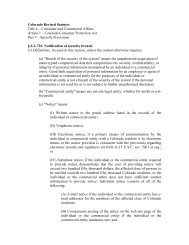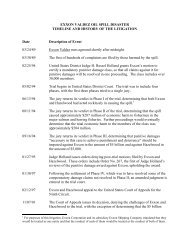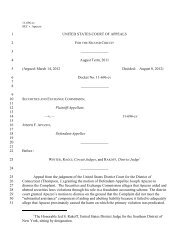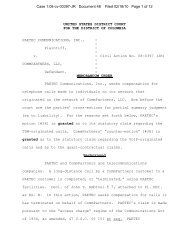QUANTA SERVICES INC, QUANTA SERVICES MANAGEMENT ...
QUANTA SERVICES INC, QUANTA SERVICES MANAGEMENT ...
QUANTA SERVICES INC, QUANTA SERVICES MANAGEMENT ...
You also want an ePaper? Increase the reach of your titles
YUMPU automatically turns print PDFs into web optimized ePapers that Google loves.
form of strategic alliance or long-term maintenance agreements. Strategic alliance agreements generally state an<br />
intention to work together over a period of time and/or on specific types of projects, and many provide us with<br />
preferential bidding procedures. Strategic alliances and long-term maintenance agreements are typically<br />
agreements for an initial term of approximately two to four years that may include renewal options to extend the<br />
initial term.<br />
Backlog<br />
Backlog represents the amount of revenue that we expect to realize from work to be performed in the future on<br />
uncompleted contracts, including new contractual agreements on which work has not begun. Our backlog includes<br />
estimates of revenues to be realized under long-term maintenance contracts in addition to construction contracts. We<br />
determine the amount of backlog for work under long-term maintenance contracts, or master service agreements<br />
(MSAs), by using recurring historical trends inherent in the current MSAs, factoring in seasonal demand and<br />
projected customer needs based upon ongoing communications with the customer. The following tables present our<br />
total backlog by reportable segment as of December 31, 2011 and 2010, along with an estimate of the backlog<br />
amounts expected to be realized within 12 months of each balance sheet date (in thousands):<br />
Backlog as of<br />
December 31, 2011<br />
Backlog as of<br />
December 31, 2010<br />
12 Month Total 12 Month Total<br />
Electric Power Infrastructure Services ....<br />
Natural Gas and Pipeline Infrastructure<br />
$2,365,531 $4,959,964 $1,798,284 $4,473,425<br />
Services ..........................<br />
Telecommunications Infrastructure<br />
768,152 1,347,173 743,970 1,026,937<br />
Services .......................... 336,030 529,589 228,549 415,460<br />
Fiber Optic Licensing ................. 102,773 402,007 98,792 402,299<br />
Total .............................. $3,572,486 $7,238,733 $2,869,595 $6,318,121<br />
As discussed above, our backlog includes estimates of revenues to be realized under MSAs. Generally, our<br />
customers are not contractually committed to specific volumes of services under our MSAs, and many of our<br />
contracts may be terminated with notice, typically 30 to 90 days, even if we are not in default under the contract.<br />
There can be no assurance as to our customers’ requirements or that our estimates are accurate. In addition, many of<br />
our MSAs, as well as contracts for fiber optic licensing, are subject to renewal options. For purposes of calculating<br />
backlog, we have included future renewal options only to the extent the renewals can reasonably be expected to<br />
occur. Projects included in backlog can be subject to delays as a result of commercial issues, regulatory requirements,<br />
adverse weather and other factors, which could cause revenue amounts to be realized in periods later than originally<br />
expected.<br />
Competition<br />
The markets in which we operate are highly competitive. We compete with other contractors in most of the<br />
geographic markets in which we operate, and several of our competitors are large companies that have significant<br />
financial, technical and marketing resources. In addition, there are relatively few barriers to entry into some of<br />
the industries in which we operate and, as a result, any organization that has adequate financial resources and<br />
access to technical expertise may become a competitor. A significant portion of our revenues is currently derived<br />
from unit price or fixed price agreements, and price is often an important factor in the award of such agreements.<br />
Accordingly, we could be underbid by our competitors in an effort by them to procure such business. Economic<br />
conditions have increased the impacts of competitive pricing in certain of the markets that we serve. We believe<br />
that as demand for our services increases, customers will increasingly consider other factors in choosing a service<br />
provider, including technical expertise and experience, financial and operational resources, nationwide presence,<br />
industry reputation and dependability, which we expect to benefit larger contractors such as us. In addition,<br />
competition may lessen as industry resources, such as labor supplies, approach capacity. There can be no<br />
8

















